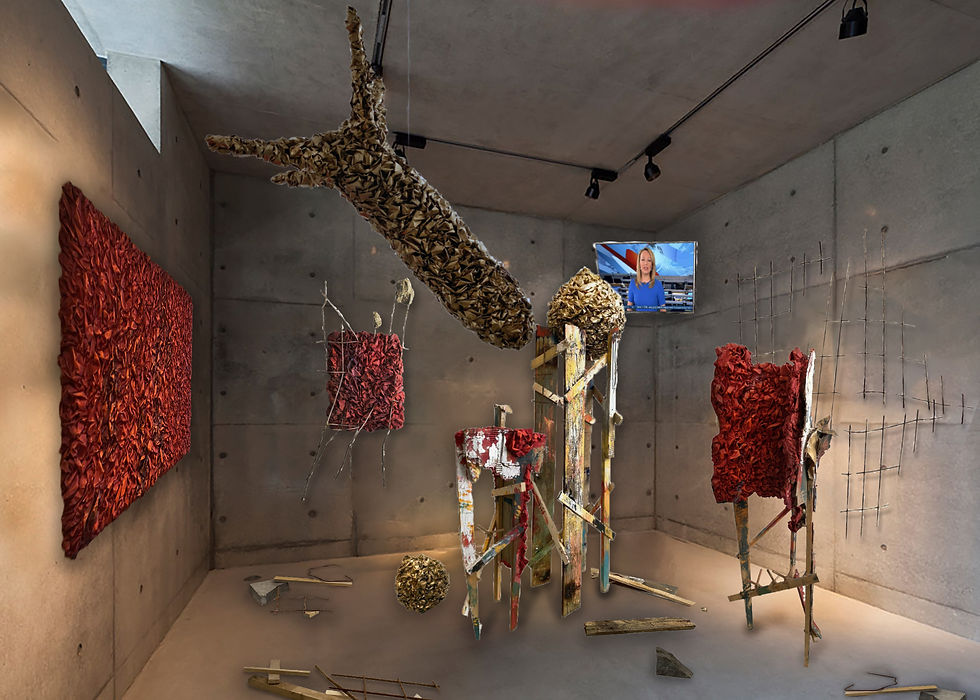

There was no plan, no thoughts, only pain. A bit melancholic, but that's probably the only thing I felt for sure. Now, after the "A monument for our times" project is ready, I somehow feel better. Relieved.
What kind of work did it turn out to be? - I do not know whether this is a cure for me, whether it is criticism, whether it is reality.
I did not make any sketches or preliminary drawings. My excuse is a number of artists who work without sketches—for example, Franz West, whom I paid attention to so often. Even Phyllida Barlow, although she does a huge amount of drawings, as a result when she starts to work, it is always an adventure with no known end.
These are small tests and thoughts. I'm working on them along the way.
There were sketches, but in this form:
Here, for example, I realized, that this sketch turned out to be very Russian. External beauty and decoration, but at the same time simple, and ordinary pieces of wood.
This form turned out to be very successful, but it does not fit in terms of volume and story to the general group in the installation.
There were errors in colour, or it was going in the wrong direction.
Here (in the background of the photo) I tried to combine the straight plane and a metal structure in the form of a cross, unfortunately, the idea did not work.
So this is the direction of my thoughts. And, unfortunately, not everything can be photographed, because sometimes it's seconds, and the moment is lost, but conclusions are made.
I started this project by visiting a building warehouse. In this project, I used mostly recycled materials, with the exception for paints and screws.
The starting point for me was the work of Marwan Rechmaoui.
I had never heard of this artist before. And what attracted me immediately to his work was his exploration of society and urban space during the civil war. The artist used ordinary ways of creating paintings and drawings until he began to depict concrete. He wondered why to paint concrete structures with acrylics when one could just use concrete. So the artist found one of his materials that is closely related to the object of his research.

45, 2014 Marwan Rechmaoui Basel 2016 [online] At: https://www.artbasel.com/catalog/artwork/37311/Marwan-Rechmaoui-45 (Accessed 30.06.2022)
Here I can draw a parallel with myself. I have always lacked colour volume on canvas when working with oil. By trial and error, I found airy paper. Now with the current situation, my newspapers have become the epitome of propaganda. Every day, painting over with paint the news and events described on the sheets, I do not stop thinking about what role such information can play.
The torn flesh of iron and cement seemed to be the result of the destructive actions of the Russians in Ukraine. What we see on social networks, and what many Russians deny, saying it's not us, but the Ukrainians themselves.
Working steps:
Such a surreal situation... In one family relatives do not trust each other about the facts of the war, and parents say that children are lying. Such absurdity brings confusion into the heads of all. I heard stories when Ukrainians listened to Lavrov on TV, and then they wondered - maybe everything really is not as we are told. In such a situation, I wanted to add insanity to the material. No matter how beautiful, and solemn everything is, "loud music" sounds and here it is a rocket.

Yes, direct and in the forehead. Figurative, kitsch. But how do show the absurdity and surrealism? When in my country is the last century in education and healthcare for the majority of the population, the regions are ruined and rotten, but we fly "golden" rockets at our neighbours.

Unlike Phyllida Barlow, who seeks to analyze the passage of time, the state of an object, and our interaction with it, I do something different. I noticed that in any work, even using everyday objects, I get extremely figurative. It is interesting for me to observe the meanings that emerge from such intricacies.
Here religion is built of rotten wood, but gilded pomposity lifts us through the domes.

There's flesh, meat, blood, red... or the wings of an angel who isn't allowed to sit on a perch. And on the other hand, this is part of the church with numerous wallpapers, which were converted into offices during the Bolshevik's time - I have seen this many times in Moscow and elsewhere in Russia.

It is a ruined church chapel.

Or my synaesthetic perception of the Homeland.
I often perceive events in colour. This phenomenon is called synaesthesia. This colour is my physical experience of the place. It is a complex and rich red that combines the experience of the past and the breath of today. So a person passing by can plunge into this pulsating red and become a part of it. This is the possibility to perceive something through a complex experience of colour, space and time.

Later it transformed into something more dramatic...

All these speculations are personally mine. The viewer will see something new, and create his own unique interpretations.
The work turned out to be static, only the rocket hovers and moves. Let it be. The fairy tale stopped.
On the whole, it is like a book with chapters and primary and secondary characters. Only the difference is, that in the book, we perceive the written plot and create our visual images. In these sculptural art objects, the visual images are given, and the viewer will create a new story.
I wanted to call this installation "Homeland".
The composition consists of six elements:
Homeland, 2022, paint, spray colours, plaster, paper on canvas, 106 x 126 x 9 cm.
Fake, 2022, recycled wood, paper, cardboard, metal, concrete; paint, plaster, 120 x 71 x 30 cm.
Russian missile, 2022, recycled wood, paper, cardboard; paint, plaster, 67 x 124 x 57 cm.
Tower, 2022, recycled wood, paper, plastic; paint, spray paint, screws, plaster, 202 x 60 x 55 cm.
Sacrarium, 2022, recycled wood, paper, cardboard, rope; paint, polyurethane foam, plaster, 155 x 57 x 45 cm.
Aisle, 2022, recycled wood, paper, cardboard, rope, plastic; paint, polyurethane foam, plaster, 124 x 42 x 47 cm.
For the final exposition, in the "red corner" where the icon is usually placed in Russia, I hang a TV with a live broadcast of the "Russian First Channel". OR recorded version with the English translation.
This is also a reference to Malevich's (born in Kiev in 1879 and died in St. Petersburg in 1935) exhibition 0.10, where in the Red Corner hung the revolutionary by those standards Black Square painting.
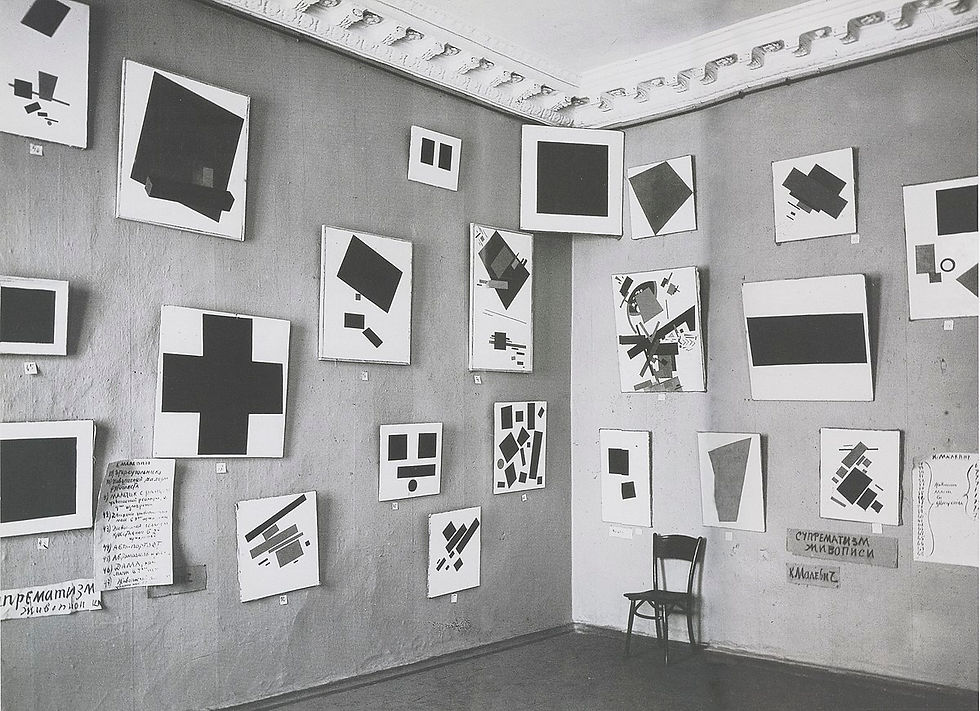
0.10 Exhibition [online] At: https://en.wikipedia.org/wiki/0,10_Exhibition (Accessed 28.05.2023)
Modern Russian directors - Andrei Zvyagintsev, Kirill Serebrennikov, Kantemir Balagov and many others have long noticed the role of television in Russian culture. They included television in their films in the background or gave it a central role, or made it an interlocutor ... They were terribly right.








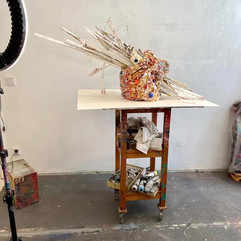


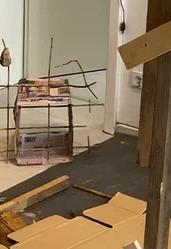


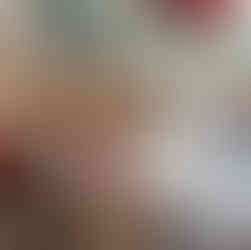


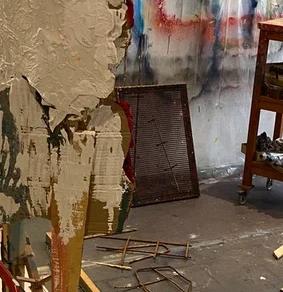










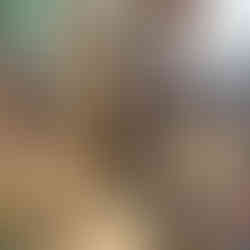









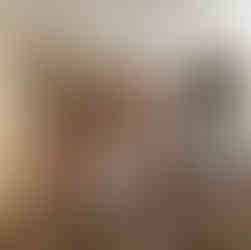

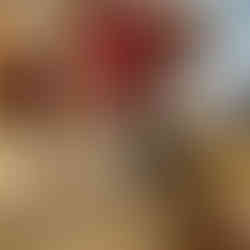










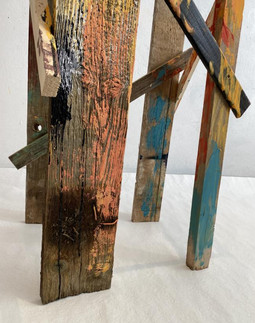














Kommentare